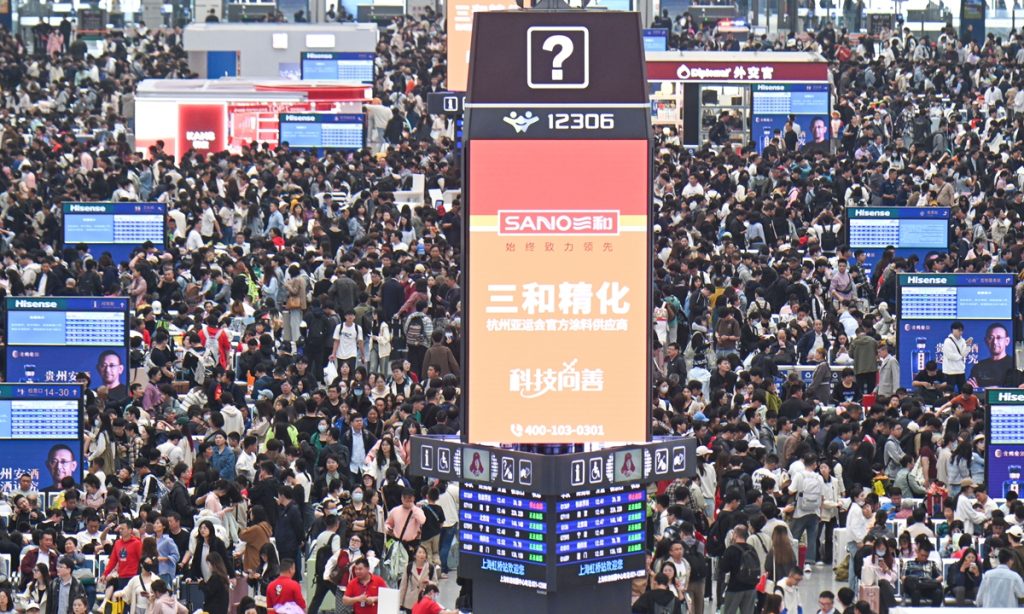Travel boom in May Day holidays shows economic vitality, potential

From enthusiastic visitors sitting in malatang (spicy soup) restaurants in Tianshui, Northwest China's Gansu Province, to crowds flocking in droves to Shanghai's dazzling Bund area at night, and to the bustling camping sites on the outskirts of Beijing, China experienced a tourism frenzy during the five-day May Day holidays from Wednesday to Sunday.
Consumption in China, the world's second-largest economy, has been firing on all cylinders during the May Day holidays, with box office and other retail spending witnessing a robust momentum. The spending spree points to a fast-lane recovery in the travel market.
As May Day holidays spending is deemed a barometer on Chinese consumer sentiment, observers said the momentum in the tourism market underscores the huge potential of the country's consumption and its consolidated role in boosting the economy throughout the year. It is projected that China's social retail sales will expand above 5 percent in 2024, buttressing the economy to navigate through rising uncertainties and head toward the GDP target of around 5 percent, experts noted.
The country saw a total of 1.36 billion passenger trips during the May Day holidays, according to data from the Ministry of Transport. Also, a record high of 280 million passenger trips were made on Wednesday, the first day of the May Day holidays.
The country's railway network is expected to handle 144 million passenger trips during May Day holiday travel rush from April 29 to May 6, according to China Railway, Xinhua News Agency reported.
"We are seeing a full-fledged recovery in the tourism market [during the May Day holidays], whether from the supply side or the demand side. On the one hand, the domestic tourism market is further consolidating its rebound momentum since the second half of last year. On the other hand, the outbound tourism market also staged a fast recovery pace," Xu Xiaolei, a marketing manager at CYTS Tours Holding Co, told the Global Times on Sunday.
Data from travel platform Fliggy showed that bookings for domestic tours via the platform recorded double-digit growth compared with last year, both in the number of bookings made per person and average spending per person.
As infrastructure improves and hospitality capabilities expand, travel to third-tier and fourth-tier cities as well as county-level travel destinations is popular, with bookings to most of those places increasing at a much higher rate than first- and second-tier cities, according to data of trip.com. The new trend, the company said, reflects "a broadside market boom under which the range of travelers expands, travel destinations diversify and the foundation of tourism recovery is further cemented."
While increasing bookings could presage a stable market, industry insiders are also putting great emphasis on consumer spending patterns, which they said is consequential in gauging the "sustainability of the tourism recovery."
"Tourists are more willing to spend this year based on my observations, and we project revenue during the holidays will rebound to pre-COVID level, lending us confidence that this year is poised to be a banner year for all tourism practitioners," a manager surnamed Li at a homestay in Datong, North China's Shanxi Province, told the Global Times on Friday. All homestay rooms were fully booked ahead of the holidays.
With regard to outbound tourism, data from qunar.com showed that international tickets and hotel reservations via the platform have set a record high for the May Day holidays period. The stepped-up recovery was fueled by multiple factors, including more visa exemption policies, a surge in international flight capacity and more convenient entry and exit measures, the platform said in a statement sent to the Global Times on Sunday.
"The China holidays have brought 'a peak season' for the global tourism market, and the waves of Chinese outbound travelers have also driven global consumption recovery," qunar.com noted.
"The travel rush could lead to a multiplier effect on tourism economic growth. In particular for smaller cities, the amplifying effect could even be twenty-fold. For example, while eating a spicy dish in Tianshui costs only about 30 yuan per person, it is estimated it could drive local consumption up to 650 yuan," said the report.
Observers said the upbeat data shows that China's services consumption has continued its recovery streak in the holidays, while goods consumption is also picking up. "There's a clear and robust momentum in the consumption recovery," Tian Yun, a veteran economist, told the Global Times on Sunday.
Despite a moderate growth in consumer spending in the first quarter, the potential for consumption will be further realized looking through the year, with "stable and progressive expansion" in the scale of consumption, according to Tian.